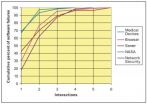Infant foods should be screened for mycotoxins
2010-11-11
(Press-News.org) ANTWERP – An international team of scientists calls for protecting complementary food for infants in developing countries – especially those where corn is a staple food – against fumonisin, a toxin produced by fungi. Until now, physicians thought the growth retardation of children in those regions was to be blamed on the poor nutritional value of the complementary maize porridge they receive when breast milk is no longer sufficient. But toxins indeed are involved, the scientists report in the journal Molecular Nutrition and Food Research.
The call is made by scientists of the Institute of Tropical Medicine Antwerp and their colleagues of the Tanzania Food and Drugs Authority and Gent University. Until now, not much attention was paid to mycotoxins in food (mycotoxins are toxins produced by fungi) – with the exception of aflatoxin, of mouldy nuts ill fame. But their research in rural Tanzania does connect fumonisin with stunting and underweight. It is the first time anybody establishes this association.
Worldwide, 1 child in 3 suffers from growth retardation and 1 in 4 is underweight. The problems of stunting and underweight are associated with over 5 million deaths of children less than 5 years annually. 70% of these deaths are concentrated in sub-Saharan Africa and South Asia. Malnutrition is implicated in the majority of these deaths.
Already in 2004, the same researchers reported that improving the nutritional quality of complementary foods does not reduce stunting and underweight in Tanzanian toddlers. This raises questions about the actual management of malnutrition by international aid organisations.
So the research team went looking for other possible causes of poor growth as soon as breastfeeding falls off and maize porridge is introduced. They knew aflatoxin, the most notorious mycotoxin, had been observed to impair child growth in Benin and Togo. So they explored for other fungal toxins that could end up in maize based complementary foods.
They observed that children of twelve months, who through their corn flour based complementary food were exposed to fumonisin above the WHO maximum tolerable daily intake (2μg/kg body weight), were significantly shorter and lighter than their counterparts.
Fumonisin enters the food chain through fungi growing on maize, the staple food in Tanzania – and in many other parts of the world. The fungus can be present without being visible to the untrained eye. It can be prevented by correct storage of the maize.
INFORMATION:
END
ELSE PRESS RELEASES FROM THIS DATE:
2010-11-11
The road to exascale computing is a long one, but the Georgia Institute of Technology, a new leader in high-performance computing research and education, continues to win new awards and attract new talent to drive technology innovation. From algorithms to architectures and applications, Georgia Tech's researchers are collaborating with top companies, national labs and defense organizations to solve the complex challenges of tomorrow's supercomputing systems. Ongoing projects and new research initiatives spanning several Georgia Tech disciplines directly addressing core ...
2010-11-11
A Finnish study confirms the hypothesis that infant feeding plays a role in the initiation of the disease process leading to type 1 diabetes in children carrying increased genetic disease risk.
The study population comprised 230 newborn infants with at least one family member affected by type 1 diabetes and a predisposing genotype based on screening cord blood at birth. The participants were randomized into two groups; the infants in the intervention group were weaned to a highly hydrolyzed casein-based formula (Nutramigen, Mead Johnson Nutrition), while those in the ...
2010-11-11
EAST LANSING, Mich. — In a major breakthrough that comes after decades of research and nearly half a billion treatments in humans, scientists have finally unlocked how a key anti-parasitic drug kills the worms brought on by the filarial diseases river blindness and elephantitis.
Understanding how the drug ivermectin works has the potential to lead to new treatments for the diseases, in which the body is infected with parasitic worms, said Charles Mackenzie, a professor of veterinary pathology in the College of Veterinary Medicine and researcher on the project. The diseases ...
2010-11-11
New hemlock hybrids that are tolerant to the invasive insect known as hemlock woolly adelgid have been created by U.S. Department of Agriculture (USDA) scientists.
Geneticist Richard Olsen and horticulturist Sue Bentz of USDA's Agricultural Research Service (ARS) teamed up with Forest Service entomologist Mike Montgomery to breed and select these tolerant hybrids. Olsen and Bentz work in the U.S. National Arboretum's Floral and Nursery Plants Research Unit in Beltsville, Md. The arboretum is located in Washington, D.C., and is operated by ARS, the principal intramural ...
2010-11-11
Gone are the days when a doctor's only way of helping patients is by treating the disease after symptoms have started. Instead, a new approach to medicine, called "Desktop Medicine" is emerging, in which the emphasis shifts from diagnosing diseases and treating symptoms to identifying risk-factors for medical conditions such as hypertension and osteoporosis, and intervening before they develop. The commentary appears in the current issue of the Journal of the American Medical Association.
"Desktop medicine," a model defined by Jason Karlawish, MD, Associate Professor ...
2010-11-11
By the end of this year, colonoscopy screening will have prevented bowel cancer in approximately 99 000 people since it was introduced in Germany. This is the result obtained by Hermann Brenner of the German Cancer Research Center in Heidelberg and his co-authors in their interim assessment conducted eight years after the procedure was added to the German cancer screening program. The authors present their projection and initial results of colonoscopy screening in Germany in the current edition of Deutsches Ärzteblatt International (Dtsch Arztebl Int 2010: 107(43): 753 ...
2010-11-11
Researchers at the National Institute of Standards and Technology (NIST) have released an updated version of a computer system testing tool that can cut costs by more efficiently finding flaws. A tutorial on using the tool accompanies the new release.
Catching software "bugs" before a program is released enhances computer security because hackers often exploit these flaws to introduce malware, including viruses, to disrupt or take control of computer systems. But it's difficult. A widely cited 2002 study prepared for NIST* reported that even though 50 percent of software ...
2010-11-11
A team of researchers from the University of Minnesota's College of Liberal Arts and College of Science and Engineering have found that an early part of the brain's visual system rewires itself when people are trained to perceive patterns, and have shown for the first time that this neural learning appears to be independent of higher order conscious visual processing.
The researchers' findings could help shape training programs for people who must learn to detect subtle patterns quickly, such as doctors reading X-rays or air traffic controllers monitoring radars. In addition, ...
2010-11-11
National Institute of Standards and Technology (NIST) researchers have developed new certified reference materials for measuring amounts of organic acids in dietary supplements formulated with Vaccinium berries—cranberries, blueberries and bilberries. As described in a recent paper,* manufacturers and researchers can use this new suite of standard reference materialsTM (SRMs) as quality assurance tools.
berry SRMs
Dietary supplement manufacturers often include health claims on products made with Vaccinium berries. Suggested benefits include prevention of urinary tract ...
2010-11-11
Many aspects of the German Genetic Diagnostics Act (Gendiagnostikgesetz) are out of touch with the latest technology, almost impossible to implement in clinical practice, or even detrimental to the success of recognised screening tests, such as newborn screening. The Act, which came into force in February 2010, is in desperate need of amendment. This was the conclusion reached by the Academy Workgroup "Predictive genetic diagnostics as an instrument of disease prevention" of the German Academy of Sciences Leopoldina, the Berlin-Brandenburg Academy of Sciences and Humanities ...
LAST 30 PRESS RELEASES:
[Press-News.org] Infant foods should be screened for mycotoxins


